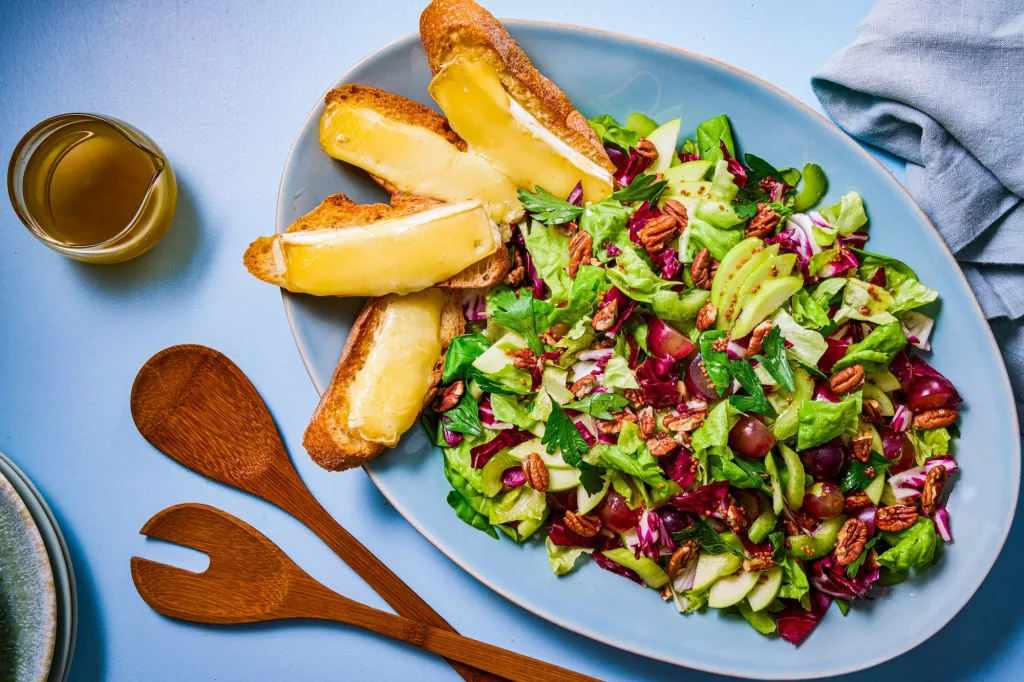
Cobb. Wedge. Louie. Waldorf. Among America’s long-standing salads, the Waldorf stands out. For one thing, it’s probably the oldest of the four. It’s also arguably the most humble. The original recipe, first served at the Waldorf Astoria hotel in New York City in 1893 — and first published in 1896 — contains just three ingredients: apples, celery and mayonnaise.
I’ve read that the trio were served atop a bed of lettuce, and that, at some point not long after the salad’s inception, walnuts and grapes joined the mix. Like the Cobb, the Waldorf lends itself to interpretation. I’ve seen it made with dozens of other ingredients, including raisins, almonds, chicken, tuna, cinnamon, caviar, potatoes and peas. In this modern variation, I’ve mixed sweet butter lettuce with bitter radicchio, skipped the mayonnaise, replaced walnuts with pecans and, to help make it a full meal, added brie toasts.
Still, I find it amusing that such a simple salad came out of such an ornate place.
Almost 10 years ago, New York’s Waldorf Astoria closed to undergo extensive renovations. When it reopened in July, with plush new rooms and plenty of brass and marble, Waldorf salad was again on the menu. But there’s a new executive chef behind it: Michael Anthony, whom New Yorkers may recognize from his post as executive chef at the hyper-seasonal Gramercy Tavern.
Six months before the Waldorf Astoria was to reopen, Anthony received an original copy of “The Cook Book by ‘Oscar’ of the Waldorf,” published in 1896, a gift from a friend. “I found it interesting to see that the salad wasn’t just a myth, it was a real creation,” he told me.
Still, he always knew he wasn’t going to serve the original salad at Lex Yard, the spacious new main dining room at the refurbished hotel. “I wanted to make a creative salad,” Anthony said. “It had to be enticing over and over again, approachable, but still live up to people’s expectations of elegance.”
I haven’t tasted Anthony’s Waldorf, but he describes it as a layered dish, with a base of cold lettuces and greens that are cut into easy-to-eat pieces. On top of that is a mixture of celery, apples, grapes and walnuts, also chopped into bite-size pieces. The walnuts are toasted and caramelized. Finely grated New England cheddar cheese is a new component, as are sunflower seeds and a honey-lemon-saffron vinaigrette. It sounds lovely. Unlike the original, it also sounds like a salad that would come out of a hotel where a room this weekend will cost you more than $1,500 per night.
Fortunately, as Anthony told New York magazine, “there’s not one almighty Waldorf salad.”
While I tested this one, I joked that I’d name it a “brie-dorf,” because it strays far from the original. There’s no mayonnaise, for one thing, because, as I tested the dressing over and over, I felt as if it weighed it down. Instead, you’ll serve this platter of crisp lettuces, tart apple, crunchy celery and pecans with a mustardy apple cider vinaigrette and baguette toasts covered in melty brie. As my colleague Rachel Kurzius recently told me in a conversation about dinner, “We should all be eating more melted brie.” Indeed, Rachel. This one’s for you.
Modern Waldorf Salad With Brie Toasts
This update on the Waldorf salad amplifies the crunch and flavor of the classic, which was invented at New York City’s Waldorf Astoria hotel in 1893. The original, which contains just apples, celery and mayonnaise — walnuts were added sometime later — might feel heavy to contemporary palates. Here, tart apples (Granny Smith) balance sweeter flavors; celery adds its grassy, vegetal crunch; sweet lettuce mingles with bitter chicories; the mayonnaise is replaced by a zippy vinaigrette; grapes contribute juicy sweetness; and toasted pecans replace walnuts. To make it a meal, you could add chicken, shellfish or rich, melty brie toasts, as we do here.
Makes 2 to 4 servings (10 cups salad)
INGREDIENTS
4 to 8 slices baguette, sliced on an angle
1/3 cup (1 1/3 ounces) raw pecan halves
2 tablespoons apple cider vinegar
2 tablespoons apple cider or water
1 teaspoon whole-grain mustard
1/4 cup extra-virgin olive oil
Fine salt
Freshly ground black pepper
4 ounces brie, sliced, cold
1/2 head radicchio, frisee, or other chicory (6 to 8 ounces total), sliced or chopped
1 small head butter lettuce (6 to 8 ounces), cored and chopped
4 stalks celery hearts, sliced on an angle
1 cup seedless grapes, preferably red, halved (about 15)
1 small green apple (6 ounces), such as Granny Smith, halved, cored and thinly sliced
Fresh flat-leaf parsley leaves, for serving
DIRECTIONS
1: Position a rack in the middle of the oven and preheat to 375 degrees. Have ready a shallow serving bowl or platter near your workspace.
2: Line a large sheet pan with foil, if desired, and place the baguette slices on one side of the pan. Spread the pecans in an even layer on the other side. Transfer the sheet pan to the oven for 2 to 4 minutes, or until the bread is lightly toasted. Transfer the bread to the serving platter, and return the sheet pan to the oven. Toast for another 3 to 4 minutes, or until the pecans are a shade darker and fragrant. Remove from the oven and set aside to cool on the pan. (Leave the oven on.)
3: In a small bowl, whisk together the vinegar, cider and mustard until well combined. Drizzle in the oil while whisking constantly to form an emulsified dressing. Season to taste with salt and pepper.
4: Transfer the pecans to a cutting board. Return the toasted baguette slices to the sheet pan, and top each piece with a slice of brie. Bake for 2 to 3 minutes, or until the cheese is partially melted.
5: Meanwhile, in a serving bowl or platter, gently toss the radicchio, lettuce, celery and grapes together. Roughly chop the toasted pecans and sprinkle them over the salad. Arrange the apple slices on top, fanning them out, if desired, and drizzle the dressing over everything. Top with the brie toasts, garnish with parsley and serve, family-style.
Substitutions: Pecans can be replaced with walnuts or hulled pumpkin seeds (pepitas). Instead of apple cider vinegar, you can use white wine vinegar. Whole-grain mustard can be traded out for Dijon or brown mustard. Don’t have brie? Use Camembert, other triple-cream cheese or another kind of melting cheese, such as cheddar. Granny Smith apples can be replaced with other tart apples. Instead of radicchio or frisee, use other types of chicories. Butter lettuce can be replaced with any type of thin, tender leafy greens. No parsley? Use tarragon or basil.
Storage note: Refrigerate the salad, dressing and brie toasts separately for up to 2 days.
Recipe from G. Daniela Galarza.
Subscribe to our weekly newsletter, In The Know, to get entertainment news sent straight to your inbox.



